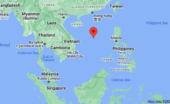Molly Minturn - My family is heartbroken to share that my father died in surgery on Monday, Feb. 10. It…
Wollemi Pine
Written by Diana Thebaud Nicholson // January 5, 2009 // Biodiversity, Montreal, Science & Technology // Comments Off on Wollemi Pine
The Wollemi™ Pine is one of the world’s oldest and rarest plants dating back to the time of the dinosaurs. With less than 100 adult trees known to exist in the wild, the Wollemi™ Pine is now the focus of extensive research to safeguard its survival. More
The Wollemi Pine – a very rare discovery
The dramatic discovery of an evolutionary line thought to be long extinct is even more remarkable with these tall and striking trees growing only 150 km from Sydney, the largest city in Australia. They were found in the extremely rugged Wollemi National Park, a largely undisturbed wilderness area.
It’s rare, it’s endangered, it’s strange looking, and at first we didn’t know all that much about it. More from the Botanic Gardens Trust, NSW, Australia
5 January 2009
Celacanto o dino-formica, non chiamateli “estinti”
Sei animali e una pianta preistorica, tutti creduti scomparsi e riavvistati dagli esperti. Del picchio dal becco d’avorio esistono solo 8 coppie, del takahe 130 esemplari
(La Repubblica) … Ma è forse il Wollemi Pine la scoperta più sensazionale nel campo scienze naturali del nostro millennio. Questo pino gigantesco era considerato estinto, noto soltanto grazie al ritrovamento di fossili risalenti a 90 milioni di anni fa. Scienziati australiani hanno però individuato nel 1994 alcuni esemplari ad ovest di Sydney, in una gola piovosa all’interno dei 200mila ettari del Wollemi National Park, nelle Blue Mountains. Il più grande Wollemi Pine è alto più di 40 metri e largo 1,2.
22 November 2008
Beauty of the ancient Wollemi pine
I have one plant in my garden that dates back to the age of dinosaurs – the Wollemi pine, a tree that dates back more than 200 million years.
October 2007
Le Jardin botanique s’enrichit d’un fascinant « pensionnaire »
(Agence Science-Presse) Il est maintenant possible de contempler au Jardin botanique de Montréal un exemplaire de l’un des arbres les plus rares au monde : le pin Wollemi. Il n’en existe plus qu’une centaine d’individus, rassemblés dans un endroit gardé secret du parc national Wollemi, à 200 km à l’ouest de Sydney en Australie.
Afin d’assurer sa survie et peut-être un jour sa réinsertion un peu partout dans le monde, un programme de multiplication a été mis sur pied à l’échelle internationale. Ainsi, plusieurs jardins botaniques d’Europe et d’Amérique – dont le Jardin botanique de Montréal — ont pu obtenir un spécimen cultivé de ce conifère, lequel trône actuellement dans la serre abritant la collection des penjings.
Ce spécimen fait environ deux mètres de hauteur. Magnifique, son écorce fait penser à des bulles de chocolat en ébullition. Plus étrange encore est son classement dans la nomenclature des espèces connues…
22 May 2007 (International Biodiversity Day)
High-Level Event at the Montreal Botanical Garden
The day’s events began with a tree-planting ceremony where the Montreal Botanical Garden was pleased to receive the very rare Wollemi Pine (Wollemia nobilis). Today there are fewer than one hundred specimens growing in the wild. Named for the location where it was found and the man who discovered it, this pine is considered one of the world’s rarest species. In order to safeguard this precious find, UNESCO designated its habitat as a World Heritage site, and a propagation program was started to help safeguard this unique treasure.
H.E. William Fisher, the Australian High Commissioner to Canada, graciously offered the tree to the City of Montreal on behalf of the Government of Australia. Ms. Helen Fotopulos, member of the Executive Committee of the City of Montreal, accepted this gift and presented it to the Montreal Botanical Garden. As part of their partnership with the CBD, the Montreal Botanical Garden will make the Wollemi Pine part of their “Biodiversity Garden,” which plans to showcase some of the world’s unique floral biodiversity.
21 April 2007
Quirks & Quarks interview with Dr. Tim Entwisle, the Executive Director of the Botanic Gardens Trust in Sydney, Australia, the Government Botanist for the country, and one of the guardians of the Wollemi pine.
7 December 2006

Susan Murch is nurturing 50 small
Wollemi pines in her UBC Okanagan office – photo by Bud Mortenson
Jurassic Relic Offers Clues to Climate Change Survival
Learning secrets of conifer evolution could benefit forestry in a time of global warming
By Bud Mortenson
A long-lost tree species will soon begin to tell its 200-million-year-old story at UBC Okanagan, where Prof. Susan Murch, Canada Research Chair in Natural Products Chemistry, is nurturing a grove of baby Wollemi pines (Wollemi nobilis) in her office.
March 5, 2003
Nursing an “Extinct” Tree Back to Health
Elizabeth M. Tasker
(National Geographic News) In 1994 a bizarre-looking tree previously known only from 120 million-year-old fossil leaves was discovered alive and well in a rugged gorge west of Sydney, Australia.
On a hiking trip in 1994, David Noble, an officer with the New South Wales National Parks and Wildlife Service (NPWS), noticed a grove of unusual-looking trees growing in a deep, sheltered rainforest canyon. The trees had strange bark that looked like bubbles of chocolate, multiple trunks, ferny-looking leaves growing in spirals and were up to 125 feet (38 meters) tall.
Noble collected some foliage, and months of taxonomic research by botanists at the NPWS and Royal Botanic Gardens Sydney (RBG) followed. The tree was finally revealed to the world as a new genus and species, Wollemia nobilis in December 1994.
The discovery was the botanical equivalent of finding a dinosaur alive today.
Because the pines have been isolated for millions of years, they provide a rare opportunity for scientists. Research has revealed that the pines are all genetically identical, a condition previously unknown among sexually reproducing organisms. Scientists are being forced to rethink genetic theory as a consequence.
Fewer than 100 Wollemi pines exist in the wild, and scientists and horticulturists are undertaking a massive effort to cultivate additional trees to improve the species’ chances of survival. By 2005/2006 more than half a million of them will go on sale worldwide as garden and indoor plants.




